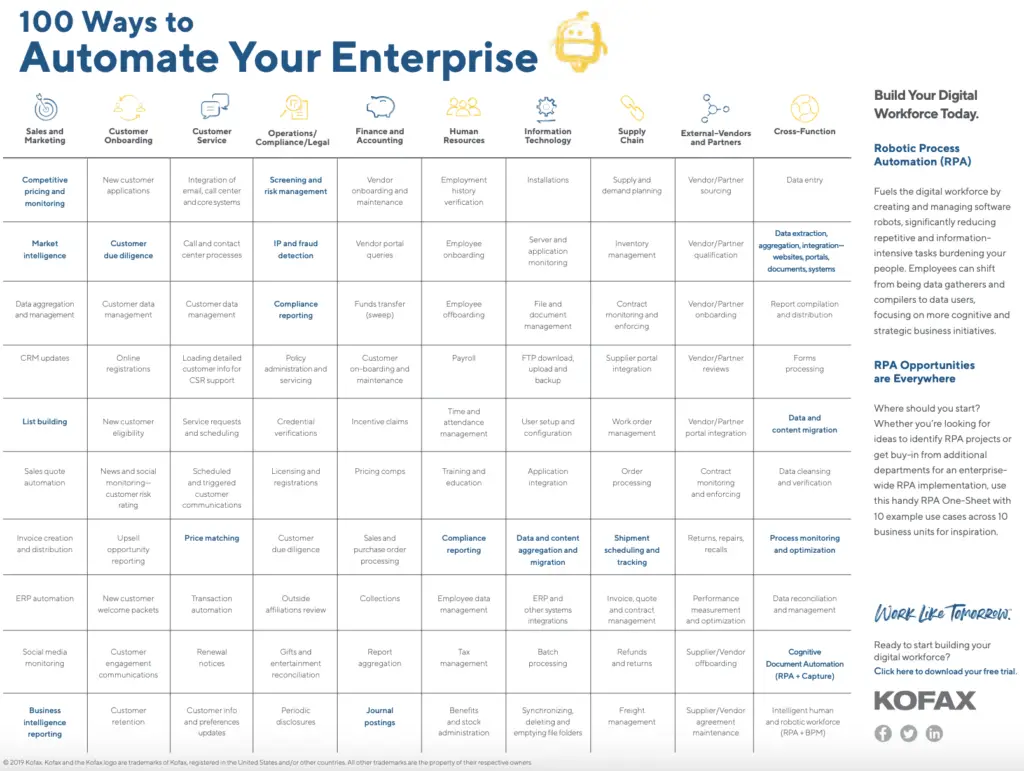Eliminate repetitive manual tasks with RPA – boost efficiency and productivity by freeing up valuable time and resources for higher-value work.
Freepik
Time is our most valuable currency, and businesses often find themselves spending it unnecessarily on tasks that are rule-based, repetitive, and require minimal human intervention. These tasks can include collecting responses from Microsoft or Google Forms, repetitive data entry, processing invoices, taking and filtering customer complaints, enhancing productivity tasks, and many more. Some of these tasks may need to run continuously or be carried out by teams located halfway across the globe. Over time, these processes can accumulate hundreds, if not thousands, of instances for some businesses. These are the tasks that can be effortlessly eliminated with Robotic Process Automation (RPA).
What is RPA?
Robotic Process Automation (RPA), also known as software technology, is a form of automation that utilizes “software robots” to handle rule-based high-volume and repetitive business processes. Unlike physical robots in assembly-line production, these bots do not require physical presence but perform tasks with extreme speed, accuracy, and the ability to run 24/7 without errors (given proper setup).
Low-code/no-code platforms or scripts can be used to set up these bots. They can interact with applications using APIs to create, deploy, manage processes, and perform actions such as moving documents from one location to another, logging into applications to download files, data entry, streamlining, email automation, data extraction, creating visual reports with charts, moving data between platforms, and more. Essentially, RPA can handle a wide range of tasks following pre-defined rulesets.
For more complex tasks, RPA can be combined with machine learning and AI. These advancements enable the software robots to generate human-like language, process semantic data, make predictions using machine learning, and execute outcomes based on those predictions, turning them into actionable results. Enables businesses to handle even the most complex tasks that require various skill sets.
Market Size
RPA market is forecast to reach $3.97 billion by 2025, with a CAGR of 31.1%.
Industry Use Case Example
Let’s take example of a large insurance company. Claim processing was a time-consuming and error-prone process. Every day, hundreds of claims were manually reviewed and processed by employees. With the implementation of RPA, these claims are now handled by software bots that can quickly process each claim, identify series of relevant information and rules like policy numbers, claimant details, and accident descriptions, and make automated decisions based on predefined rules. The bots then generate reports for review and approval by human supervisors, significantly reducing the time and effort required to process claims.
The steps involved in processing a claim can be seen as rule-based with specific triggers (a new claim being submitted), inputs (claim details), algorithms (rules for claims that get either approved or denied) outputs (approved or denied claim status, generated reports), and are repeatable for every claim. The automation of this process not only increases efficiency but also reduces the risk of human error and speeds up the overall process for customers.
What does RPA Bring to Your Business?
Organizations aim to increase profitability, flexibility, and efficiency by completing more work without adding more people. RPA allows organizations to eliminate tedious and stressful tasks, integrate seamlessly with internal and external processes, centralize individual tasks into a single executable process that can run around the clock, support multiple teams, and guarantee error-free and quick delivery times. The benefits of implementing RPA are vast, including boosting employee morale, improving tracking and debugging capabilities, and offering low-code or no-code options for easy deployment by non-technical staff.
- Increase Profitability and Efficiency: By automating high-volume, repetitive tasks, RPA can drive down costs and free up employees to focus on more strategic activities that require decision making. This helps organizations grow faster and become more profitable over time.
- Boost Employee Morale: Eliminating mundane, time-consuming tasks can significantly reduce employee stress levels and increase job satisfaction. Employees are free to take on tasks that challenge them and utilize their skills and expertise effectively.
- Seamless Integration with Existing Processes: RPA can be easily integrated into existing processes without interfering with other operations. It can be tested and launched independently, ensuring minimal disruption to the organization.
- Centralized Execution and Around-the-Clock Support: By centralizing individual tasks into a single executable process, RPA can run around the clock, providing support to multiple teams without errors or delays. This ensures that tasks are completed quickly and accurately, regardless of time zones or work schedules.
- Low-Code or No-Code Deployment Options: Low-code or no-code options allow employees to configuring low complexity RPA bots to automate tasks across various platforms. This makes it easy for non-technical staff to learn and use the technology, allowing organizations to onboard wider range of employees with different skill sets to work with RPA.
- Quick Execution and Error-Free Performance: RPA bots process complicated tasks using rules-based programming, significantly reducing the risk of errors that might occur when tasks are performed by humans.
- Improved Satisfaction: By running 24/7, RPA can reduce wait times for teams working in different time zones and provide quicker customer support, improving overall satisfaction levels.
- Accelerated Growth: By driving down costs, freeing up employees to focus on decision-making tasks, and improving efficiency, implementing RPA can accelerate growth and help organizations
achieve their goals more effectively.

Limitation and Best Practices When Implementing RPA in Business
There are several limitations when implementing RPA:
- Limited ability to understand and interpret unstructured data, such as text or images, which requires additional manual intervention or integration with optical character recognition (OCR) or machine learning (ML) tools.
- Dependence on existing systems and interfaces, which may not be compatible or require custom integrations to work effectively with RPA software.
- Limited flexibility in handling exceptions or complex situations that require human judgment or decision-making.
- Potential impact on employee morale and job satisfaction if automation leads to layoffs or changes in work processes without proper communication and support.
- Requirement for ongoing maintenance and updates to keep the RPA system functioning optimally and adaptable to changing business requirements.
When choosing processes to automate with RPA, it’s important to consider factors such as:
- The rule-based nature of the process, with clear triggers, inputs, algorithms, outputs, and repeatability for every instance.
- The potential impact on productivity, efficiency, and error reduction for employees.
- The ability to scale the automation easily across multiple systems or departments.
- The availability of integration points (e.g. API) with existing technology infrastructure.
- The potential cost savings and return on investment (ROI) from automating the process.
- The level of complexity involved in the process, considering factors such as exceptions and human judgment.
Which Industry are Benefiting from Implementing RPA? – Top 5
Misconception: RPA benefits only IT departments. However, RPA can be deployed by non-technical staff members, enabling its integration into various business units. Commonly automated processes include:
Market Size
The financial services industry, specifically banking, financial services, and insurance (BFSI), accounted for a 28.89% revenue share – the largest among other sectors adopting Robotic Process Automation (RPA) solutions, as per Grand View Research.
Banking:
– According to McKinsey & Company automation can handle almost 50% of all banking processes.
– By leveraging RPA, organizations can achieve significant cost savings and become more operationally efficient, serving as a crucial first step towards digital transformation.
– Everest Group reported that half of their surveyed enterprises show more than $1 million in cost savings from automation efforts.
Financial Services:
– McKinsey’s research reveals that approximately 42% of financial processes can be fully automated through the implementation of RPA, with an additional 19% of tasks being partially automated.
– RPA simplifies lengthy manual data entry tasks in the financial sector.
– According to Gartner, roughly 80% of finance leaders have implemented or are planning to implement robotic process automation.
Insurance:
– According to Mckinsey & Company, it’s estimated that 25% of processes in the insurance industry can be automated by the year 2025.
– By implementing RPA, insurance enterprises, both carriers and agents, can improve operational efficiency, discover new opportunities for innovation, and deliver an enhanced, empathetic customer experience.
Supply Chain Management:
– According to UiPath, 84% of B2B buyers say that it’s taking too long to get back information from their suppliers.
– 65% of short-term decision in supply chain management will get automated.
Human Resource:
– Automation can help HR boosts its onboarding processes by 10x according to UiPath.
– The Hackett Group reports that 65% of companies have adopted RPA solutions for HR services in 2022, while 78% of organizations aim to automate their employee onboarding processes according to Kofax. This indicates a growing trend towards the adoption and expansion of RPA in HR services across companies.
By deploying RPA across different business units, organizations can improve operational efficiency, reduce costs, enhance accuracy, and streamline various processes.
Action Plan
1. Identify Key Processes: Identify repetitive, rule-based, and manual processes that can be automated with RPA technology.
2. Assess Readiness: Evaluate the technical readiness of your organization to implement RPA, including available infrastructure, data security, and employee skills.
3. Choose an RPA Vendor: Select a suitable RPA vendor based on your business needs, budget, and scalability requirements. Or deploy team of engineer specifically for development of RPA scripts.
4. Design and Develop Bots: Develop custom bots that are compatible with current systems, follow established business rules, and can be easily scaled up as needed.
5. Test and Deploy Bots: The best practice is to develop RPA bots and test them in QA or Sandbox environment before deploying them in Production to ensure smooth operations before launching the system.
6. Monitor and Optimize: Monitor bot performance, gather user feedback, and make improvements for increased efficiency and precision. Set up a logging system to track RPA processes, and enable an RPA solution to automatically send emails when errors occur during process execution.
7. Scale Up: Once initial bots are deployed successfully, consider scaling up the RPA implementation by automating more processes across your organization.
8. Train Employees: Provide training to employees on the use of RPA tools, benefits, and best practices to ensure smooth adoption and continued success.
9. Measure Results: Monitor the impact of RPA implementation on operational efficiency, cost savings, and overall business performance to justify ongoing investment in this technology.
3000+ ChatGPT prompt to Boost your Business!

Make $$ and GROW your YouTube channel through NEW AI Masterclass!

CANVA DESIGNER? Use the power of AI in the Canva AI Master Class

3000+ Google Bard AI Prompts (link here)

Get the best tech tips, AI tool reviews, and more to your email.
You will receive the best editors’ picks from all of our stories, stay tune!







